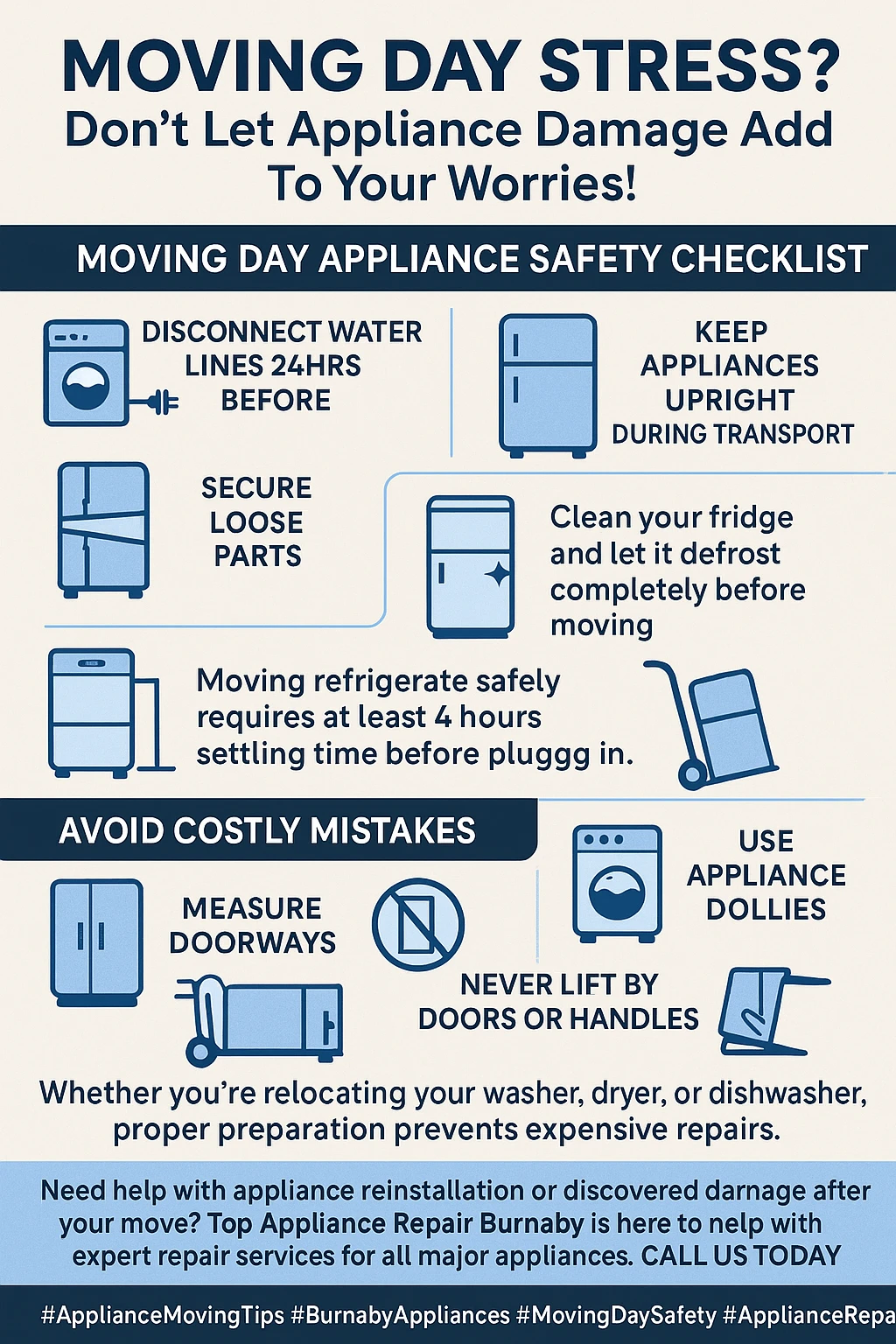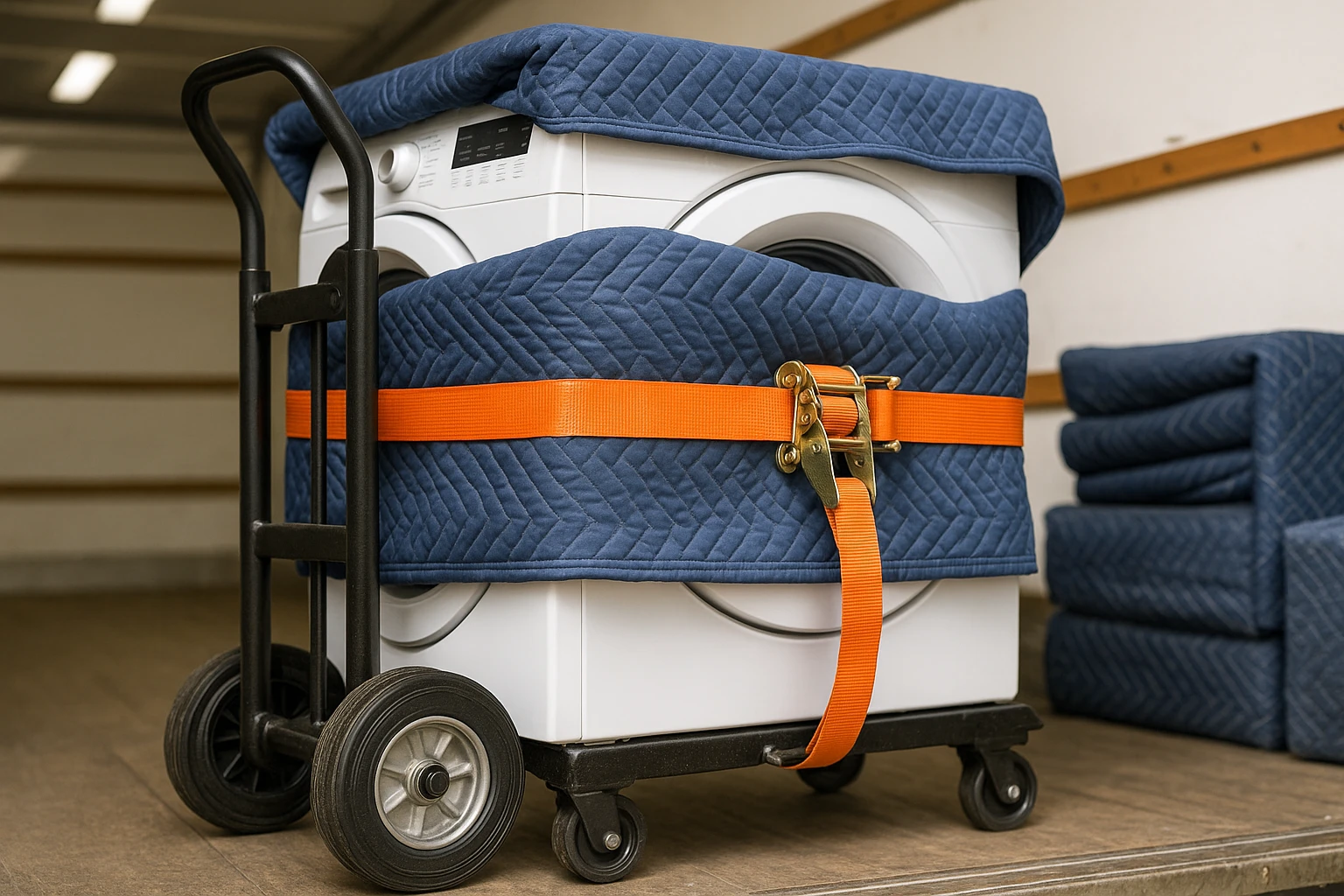Moving Day Appliance Safety: How to Protect Your Appliances During Home Relocation Without Costly Damage
Worried about your precious appliances surviving the chaos of moving day? We’ve got you covered with the most effective strategies to keep your refrigerator, washer, dryer, and other essential appliances safe during your Burnaby relocation.
Picture this: you’re standing in your empty kitchen, watching movers cart away your beloved stainless steel refrigerator that’s been faithfully keeping your midnight snacks cold for the past five years. Your stomach drops as you realize you forgot to properly prepare it for the move. Sound familiar? Whether you’re relocating within Burnaby or moving to this beautiful Metro Vancouver city, protecting your appliances during a move is absolutely crucial for avoiding costly repairs and replacements. From that trusty washer that’s seen you through countless laundry cycles to the dishwasher that’s been your dinner party hero, these household essentials deserve the same care and attention as your most treasured possessions.
Moving appliances isn’t just about lifting heavy things and hoping for the best. It’s a delicate dance of preparation, timing, and technique that can mean the difference between a smooth transition and a moving day nightmare. The good news is that with proper planning and the right approach, you can ensure your appliances arrive at your new Burnaby home in perfect working condition. Let’s dive into everything you need to know about keeping your appliances safe during your upcoming move.
Key Outtakes:
- Proper preparation 24-48 hours before moving day is essential for appliance safety and functionality
- Different appliances require specific disconnection and preparation procedures to prevent damage
- Using appropriate moving equipment like appliance dollies and protective materials significantly reduces risk
- Climate-controlled storage and proper positioning during transport are crucial for appliance longevity
- Professional movers with appliance expertise can save you time, money, and potential injuries

Understanding the Complexity of Appliance Moving

Moving appliances presents unique challenges that go far beyond simply picking up heavy objects and placing them in a truck. These sophisticated machines contain delicate internal components, electronic systems, and mechanical parts that can be easily damaged if not handled properly. Unlike furniture or boxes, appliances require specific preparation procedures that must be completed well before moving day arrives. The refrigerant systems in your fridge, the drum mechanisms in your washer, and the heating elements in your dryer all need special attention to ensure they continue functioning properly in your new home.
The weight and awkward dimensions of most household appliances create additional complications during the moving process. A standard refrigerator can weigh anywhere from 200 to 400 pounds, while washers and dryers typically range from 150 to 300 pounds each. These aren’t just heavy items, they’re top-heavy, bulky, and often have protruding handles or doors that can catch on doorways, walls, or other obstacles. The combination of weight, size, and delicate internal components means that improper handling can result in expensive repairs or complete appliance replacement.
Environmental factors during the move can also impact appliance functionality. Temperature fluctuations, moisture exposure, and vibration during transport can all affect sensitive electronic components and mechanical systems. For residents in Burnaby, where weather conditions can vary significantly throughout the year, protecting appliances from rain, snow, or extreme temperatures becomes an additional consideration. Understanding these complexities helps you appreciate why appliance moving requires careful planning and execution rather than a last-minute scramble.
Pre-Move Preparation Timeline and Essential Steps

Successfully moving appliances starts with proper preparation, and timing is everything when it comes to getting your household machines ready for relocation. The preparation process should begin at least one week before your moving date, with some critical steps requiring completion 24 to 48 hours in advance. This timeline ensures that your appliances have sufficient time to reach the proper state for safe transport while preventing any last-minute complications that could delay your move or cause damage to your valuable equipment.
Starting with your refrigerator and freezer, the defrosting process alone can take anywhere from 8 to 24 hours depending on the amount of ice buildup. Begin by removing all food items and consuming or donating perishables that won’t survive the move. Unplug the unit and prop the doors open with towels to maintain airflow and prevent mold growth. Professional moving companies recommend placing towels around the base to absorb melting ice and condensation. Once defrosting is complete, thoroughly clean and dry all interior surfaces before securing the doors with rope or bungee cords, never tape, as this can damage the finish.
Your washing machine requires special attention to remove all water from internal components and hoses. Run a final rinse cycle using warm water for approximately 30 seconds, then drain any remaining water into a container. Turn off the water supply valves and disconnect the inlet hoses, allowing them to drain completely before storing them inside the washer drum. The drain hose can be secured to the back of the unit with tape. For front-loading washers, you may need professional assistance to properly secure the drum mechanism, as unsecured drums can suffer severe damage during transport.
Electric dryers are relatively straightforward to prepare compared to their gas counterparts. Simply unplug the unit and coil the power cord neatly, either storing it inside the dryer drum or taping it securely to the back of the machine. Gas dryers require additional safety precautions including shutting off the gas supply valve and having the gas line properly disconnected by a qualified technician. Never attempt to disconnect gas appliances yourself, as improper handling can create serious safety hazards. Clean the lint filter and exhaust vent thoroughly before moving to prevent fire hazards and ensure optimal performance in your new home.
Dishwashers need complete water drainage and secure positioning for transport. Run a normal wash cycle without dishes or detergent, then manually drain any remaining water from the bottom of the tub using towels or a wet vacuum. Secure the dish racks in place or remove them entirely and pack separately to prevent internal damage. If your dishwasher is a portable unit, ensure all connections are properly disconnected and the unit is thoroughly dried before moving.
Don’t forget about smaller appliances like microwaves, toasters, and coffee makers. Remove all removable parts and pack them separately in clearly labeled boxes. Clean each appliance thoroughly and allow them to dry completely before wrapping them in protective materials. Original packaging is ideal for smaller appliances, but if unavailable, use plenty of bubble wrap and clearly mark boxes as fragile. These preparation steps may seem time-consuming, but they’re essential for preventing costly damage and ensuring your appliances work perfectly in your new Burnaby home.
Professional Equipment and Protection Methods

The right equipment makes all the difference between a successful appliance move and a disaster waiting to happen. Professional-grade moving equipment is specifically designed to handle the unique challenges that appliances present, from their substantial weight to their awkward dimensions and delicate internal components. Investing in proper equipment or ensuring your moving team has access to these tools is one of the most important decisions you can make for your appliance relocation.
An appliance dolly stands as the most crucial piece of equipment for safe appliance moving. Unlike standard dollies, appliance dollies are engineered to handle loads up to 700 pounds and feature specialized design elements that make them ideal for large household machines. These dollies have a taller back support, wider base, and often include stair-climbing capabilities with special wheel configurations. The enhanced leverage they provide reduces the risk of injury to movers while offering better control during navigation through tight spaces like doorways and stairwells.
Protective materials are equally important for preventing scratches, dents, and other cosmetic damage during the move. Heavy-duty moving blankets or furniture pads should be wrapped around each appliance and secured with moving straps rather than tape, which can damage finishes. For appliances with delicate surfaces like stainless steel, consider using specialized protective film or cardboard shields for extra protection. The goal is to create a protective barrier that cushions against impacts while allowing the appliance to be safely maneuvered.
Moving straps and tie-downs serve multiple purposes in appliance relocation. They secure protective materials in place, help bind doors shut, and most importantly, they’re essential for safely strapping appliances to dollies and securing them within the moving truck. Ratchet straps provide superior holding power compared to bungee cords and ensure appliances remain stationary during transport. When loading appliances into the truck, they should be positioned upright when possible and secured to prevent shifting that could cause internal damage.
Furniture sliders can be invaluable for moving appliances across floors without causing damage to either the appliance or the flooring surface. These smooth plastic or
